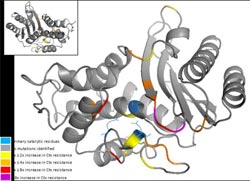Development of antibiotic resistance more predictable than expected

3D enzyme. The 48 mutations found in the enzyme TEM-1 beta-lactamase that increase resistance against the antibiotic cefotaxime. The colours indicate the increase in cefotaxime. The inset shows the same enzyme, turned 180 degrees horizontally. <br>
Research by Wageningen University, part of Wageningen UR, has shown that the development of bacteria with resistance against the antibiotic cefotaxime occurs more often and more predictably than was previously assumed.
Bacterial populations were found to have many mutations that increase resistance and therefore have a negative effect on public health. Moreover, the effects are such that it can be predicted that the development of bacterial strains with a resistance against cefotaxime will progress in a similar way in different patients from different locations.
Together with German colleagues, the Wageningen scientists developed a research approach which will allow them to predict whether, and if so how, resistant bacterial strains will develop for other antibiotics as well.
The Wageningen scientists studied the main enzyme that causes resistance against the antibiotic cefotaxime. The only function of this beta-lactamase enzyme is the breakdown of so-called beta-lactam antibiotics, which kill bacteria by preventing the production of their cell walls. Martijn Schenk and Arjan de Visser, genetic scientists at Wageningen University, were surprised by the number of mutations with a positive effect on the resistance against cefotaxime. De Visser: “Of all the mutations we found in this beta-lactamase, more than three per cent caused an increase in the resistance against the antibiotic. To top it all off, we discovered that the mutations with a strong effect also had a much greater impact than we had anticipated. Based on theoretical arguments and previous observations, we had estimated the effects on the resistance against the antibiotic to be significantly lower.”
The presence in particular of mutations with a very strong effect on resistance to the antibiotic facilitates the prediction of the development of resistant bacterial strains.
Collaboration with a group of physicists in Germany enabled the Wageningen scientists to study the genetic findings quantitatively, as Martijn Schenk explains: “The physicists built computer models that helped us as geneticists to move forward. We were able to show that it is probable that the bacteria will become resistant against the antibiotic in a similar way in various patients throughout the world.”
According to De Visser the approach taken can also be used to predict the ‘tenability’ of other antibiotics, as the combination of computer models with knowledge about the number and effect of the mutations provides concrete leads.
http://www.wur.nl/UK/newsagenda/news/PPSG_bacteria_resistance.htm
Attached files
3D enzyme. The 48 mutations found in the enzyme TEM-1 beta-lactamase that increase resistance against the antibiotic cefotaxime. The colours indicate the increase in cefotaxime. The inset shows the same enzyme, turned 180 degrees horizontally.
Table. The Wageningen scientists found an unexpectedly large amount of mutations that considerably increased the resistance of the enzyme to the antibiotic.
Full bibliographic informationSchenk, MF, IG Szendro, J Krug and JAGM de Visser. 2012. Quantifying the adaptive potential of an antibiotic resistance enzyme. PLoS Genetics 8(6): e1002783
Media Contact
More Information:
http://www.wur.nlAll latest news from the category: Life Sciences and Chemistry
Articles and reports from the Life Sciences and chemistry area deal with applied and basic research into modern biology, chemistry and human medicine.
Valuable information can be found on a range of life sciences fields including bacteriology, biochemistry, bionics, bioinformatics, biophysics, biotechnology, genetics, geobotany, human biology, marine biology, microbiology, molecular biology, cellular biology, zoology, bioinorganic chemistry, microchemistry and environmental chemistry.
Newest articles

A universal framework for spatial biology
SpatialData is a freely accessible tool to unify and integrate data from different omics technologies accounting for spatial information, which can provide holistic insights into health and disease. Biological processes…

How complex biological processes arise
A $20 million grant from the U.S. National Science Foundation (NSF) will support the establishment and operation of the National Synthesis Center for Emergence in the Molecular and Cellular Sciences (NCEMS) at…

Airborne single-photon lidar system achieves high-resolution 3D imaging
Compact, low-power system opens doors for photon-efficient drone and satellite-based environmental monitoring and mapping. Researchers have developed a compact and lightweight single-photon airborne lidar system that can acquire high-resolution 3D…





















